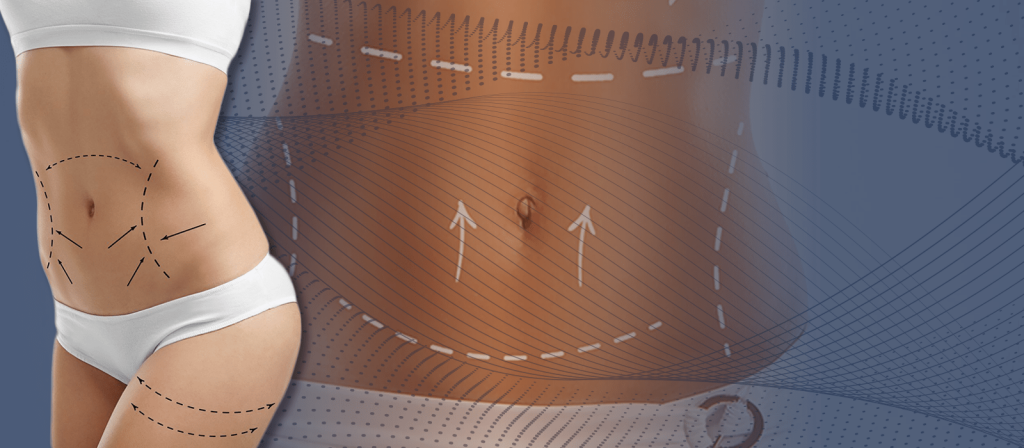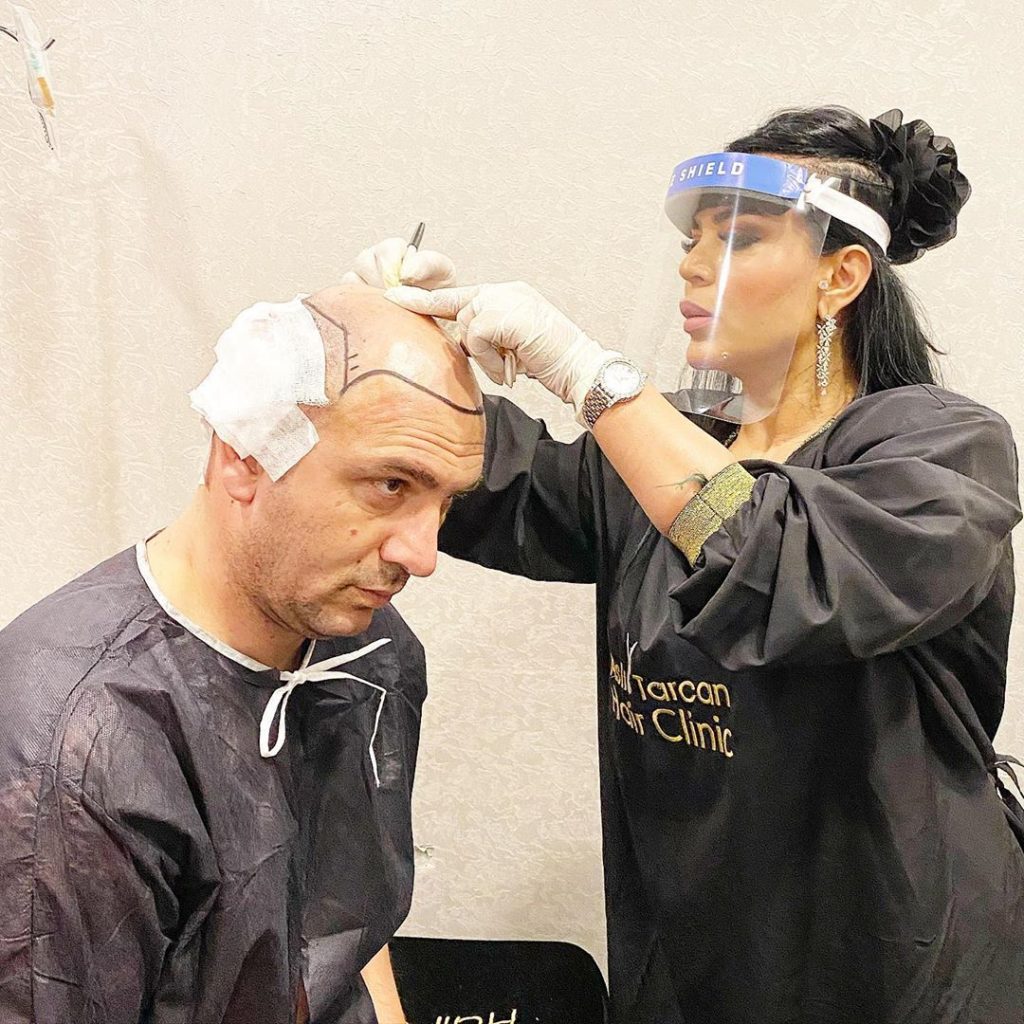
Abdominoplasty, which is known as tummy tuck, is a kind of plastic surgery operation. It is one of the most effective methods among the types of surgery applied in the areas of abdominal and belly aesthetics. Abdominal skin sagging requiring abdominoplasty usually occurs in women. However, sagging and loosening occur in men due to the deformation in the abdominal and belly skin and muscles as a result of excessive weight gain. The most important factor in women is previous pregnancies.
The muscles are separated from each other by the rupture of the tissues between the muscles that make the anterior abdominal wall and keep the internal organs inside and make the abdomen look flat, and the abdomen appears to be protruding and sagging with the push of the organs from the inside. Significant weight loss also causes the abdominal skin to loosen and sag.
If your abdomen is not only fattened, but also if the muscles are open and sagged, it is possible to achieve a brand new appearance with abdominal aesthetics, abdominoplasty surgery. With abdominal stretching surgery, at the end of pregnancy, the expanding front wall of the abdomen is narrowed, the abdominal muscles that are loosened and opened are tightened, the excess of the sagging abdominal skin is removed with fat.


Abdominoplasty Techniques
Ideal tummy tuck techniques are determined by the anatomy of the patients, the amount of excess skin and the area they are located, even the clothes they prefer.
Some plastic surgeons ask their patients to bring their favorite or most frequently worn swimwear, underwear or pants to make markings to ensure that the possible scar / incision area remains under the clothing.
It is always ideal to make the horizontal incision in the area where the underwear will hide, so that underwear can hide the wound. Some patients may have to accept scars that are longer than ideal and in a higher position. This may be necessary for patients with large amounts of excess skin on their upper abdomen.
The list below describes the most commonly used tummy tuck techniques in plastic surgery;
- Standard or Full Abdominoplasty
- Extended Abdominal Tension Operation
- Mini Abdominoplasty
Standard Or Full Abdominoplasty
It is applied by making an incision under the abdomen extending from one hip to another. At the same time, another incision is made in the lower part of the navel so that the belly button can be repositioned after the excess skin on the upper abdomen is removed.
After the abdominal muscles are tightened with internal stitches after the excess skin is removed, the remaining skin is pulled over the abdomen.
Extended Abdominal Tension Operation
The horizontal incision extends around the buttocks (sides of the waist) so that the ends of the wound are visible when a person looks at the body from behind. Extended tummy tuck surgery is generally used for patients who lose a lot of weight because it takes more skin from a larger area than the standard technique. Extended tummy tuck also requires a round incision to free the abdomen and reposition it after removing excess skin.
Mini Abdominoplasty
Mini tummy tuck is suitable only for certain patients, as it creates minimal improvement due to weight loss or natural spreading of excess skin after pregnancy. Mini tummy tuck operation, which is performed by creating a wound over 10-20 centimeters above the groin, does not improve the issues such as removing excess skin in the upper abdomen or repositioning the navel.
What Is The Difference From Standard Abdominoplasty?
Mini tummy tuck is preferred if the amount of sagging or looseness is low. The incision is shorter and there is no incision around the belly button. Full tummy tuck surgery is preferred if the amount of sagging is greater. In both techniques, liposuction can be applied to the abdominal and lateral areas. During these abdominal aesthetic surgeries, looseness or hernia repairs in the abdominal muscles can also be performed.
Abdominoplasty Process
What Should Be Done Before Abdominoplasty?
Since abdominoplasty is a surgical intervention, you should first discuss with your doctor in detail. You should state your expectations after the surgery and learn clearly what kind of results you will get. However, smoking patients are recommended to stop smoking at least 1-2 weeks before this surgery. In addition, you should not use drugs such as vitamin E and aspirin before the operation.
During The Process
In the technique applied in abdominoplasty, the area where the skin will be removed and other issues are decided in the light of the detailed examination and the radiological images examined by the physician. The sagging and cracked skin in the area up to the belly button is taken from the area, which is generally called the cesarean scar level, from the area to be drawn sideways and the skin above the belly button is stretched down. The belly button is also rebuilt in order to bring it to the appropriate position. In addition to sagging and looseness, if there is an excessive fat problem, excess fat in the abdominal area is removed by the method called liposuction. Thanks to the collecting stitches placed on the abdominal wall membranes, the loosened abdominal muscles are tightened and restored to their former stiffness. The incisions at the end of the surgery are stitched with aesthetic stitches, preventing the formation of unsightly scars. After the surgery, abdominal sagging, looseness and cracked skin problems caused by pregnancy or excessive weight gain are eliminated. However, in the event of a new pregnancy and delivery after the surgery, some of these problems may occur again.
The duration of the tummy tuck surgery varies from person to person. Although the full abdominoplasty operation, which is called total abdominoplasty, takes approximately 3-3.5 hours, the operation time can be up to 4 hours in people with a wide abdominal area. In mini tummy tuck surgeries, which are applied in patients with milder sagging, sagging, and similar problems and do not cover a large area as much as total abdominoplasty, the operation time is shorter and the operation is completed in a short time such as 1-1.5 hours. Some of the factors that affect the duration of the operation are the amount of excess skin in the abdominal area, the area of the abdominal area, the suture technique to be applied, and the condition of the abdominal muscles. The operation is performed under general anesthesia and must be done in a hospital environment with suitable conditions and equipment.
After The Abdominoplasty Surgery
Although it varies depending on the operating conditions after abdominal stretching, patients are usually discharged after 1-2 days of hospital care. Patients are generally recommended to wear special corset after abdominoplasty. This corset, which is worn continuously for 1 month, increases the success of the operation by helping the abdominal region reach the desired form. Approximately 3-4 hours after the end of the surgery, you can stand up and walk with the help of a relative, and you can walk slowly without help the day after the operation. It is normal to have pain for a while due to the procedures and stitches performed in the abdominal area during the operation and the necessary painkillers will be applied by your doctor.
You can take a bath 2-3 days after the operation and reach the comfort that you can do your daily tasks yourself. You should avoid these movements as much as possible since movements such as coughing, sneezing, and straining can hurt your stitches during the first week due to the fact that the stitches are not fully healed, and if they are severe, they may damage your stitches. If you are not working in a heavy job, you can return to your work life in about 7-10 weeks under average conditions, although it varies according to your doctor’s recommendations and whether you feel good or not. This information is valid for full tummy tuck surgeries and although the recovery time is shorter in mini tummy tuck surgeries applied to solve milder problems, patients can return to their daily lives within 3-4 days.
One of the most curious questions of people who want to have abdominoplasty is whether pregnancy after surgery will cause any complications. Tummy tuck surgery is not an operation that affects pregnancy or may cause any problems during pregnancy. The appropriate time for pregnancy in women who have a tummy tuck procedure is related to the completion of the healing process of the operation, and it is the healthiest method for the physician to decide how long after the operation can be conceived. Another issue is how long mothers who want to have abdominal stretching after pregnancy should wait. The ideal period for abdominoplasty is stated as 1 year after birth. During this period, it is possible for the mother to lose as much weight as she can with the help of regular nutrition, breastfeeding, and exercise; at the same time, it is possible to determine the exact degree of cracks and sagging. Mothers who do not plan a new pregnancy and want to stretch the abdominal region can plan the operation process by consulting a specialist at the end of 1 year after birth.
Frequently Asked Questions
How Long Can I Return To My Normal Life After Abdominoplasty Surgery?
The abdominal area will be swollen in the first few days after tummy tuck surgery. It is also normal to feel pain and discomfort that can be relieved with medication. The drains placed during the operation are usually 3-5. It is removed in days. Depending on the surgical intervention, one stay in the hospital for a few days.
Although there is difficulty in standing upright at the beginning, walking will be started in the early period. The use of stitches, dressings, washing, and corset depends on the patient’s condition and the surgeon’s preferences in the surgery and will be planned in the postoperative period.
It may take a few weeks to return to old activities after abdominoplasty. If the patient is in the good physical condition and has strong abdominal muscles, this process takes even shorter. Exercise will positively affect the healing process, reduce swelling, reduce the risk of blood clots, and help gain abdominal muscle tone. However, especially strict exercise programs that will strain the abdominal muscles; they are delayed until the period when they can easily do it.
The scars that develop due to tummy tuck surgery will show a red appearance for the first 3-6 months but will fade over time and become less noticeable. However, since these scars always remain under underwear and bikini, they do not adversely affect patients.
What Are The Risks Of Abdominoplasty Surgery?
All surgical procedures carry some uncertainties and risks. Hundreds of tummy tuck surgeries are successfully performed every year. This surgery gives very good results in the hands of an aesthetic surgeon who has experience in shaping the body. However, there are risks associated with anesthesia and special risks associated with this surgery, which can be seen in all surgical procedures.
Special risks that can be seen after abdominoplasty include wound infection, accumulation of blood or body fluid in the surgery area, blood clotting, and poor wound healing. Wound infection can be resolved with drainage and antibiotic use. Although the accumulation of blood or body fluid in the operation area is rarely seen due to the drains placed in the surgery, it can be removed with a second intervention when necessary.
Blood clotting (embolism) is a complication that should be kept in mind, especially in elderly patients, that can risk life and can be seen after any surgery. This risk is usually eliminated by lifting the patient up and walking early after abdominoplasty, using compression stockings, and using some medications.
Poor wound healing usually results in distinct scars. This situation sometimes makes you think of a second intervention to remove these bad marks. The risk of bad wound healing is higher in people who smoke and have systemic diseases that disrupt wound healing (such as diabetes).
Can Liposuction Be Performed With Abdominoplasty?
The answer to this question is hidden in the technique your doctor will use. In classical techniques, fat removal cannot be done with this surgery. However, as the surgery is simplified in the latest techniques, as much fat can be removed as desired.


